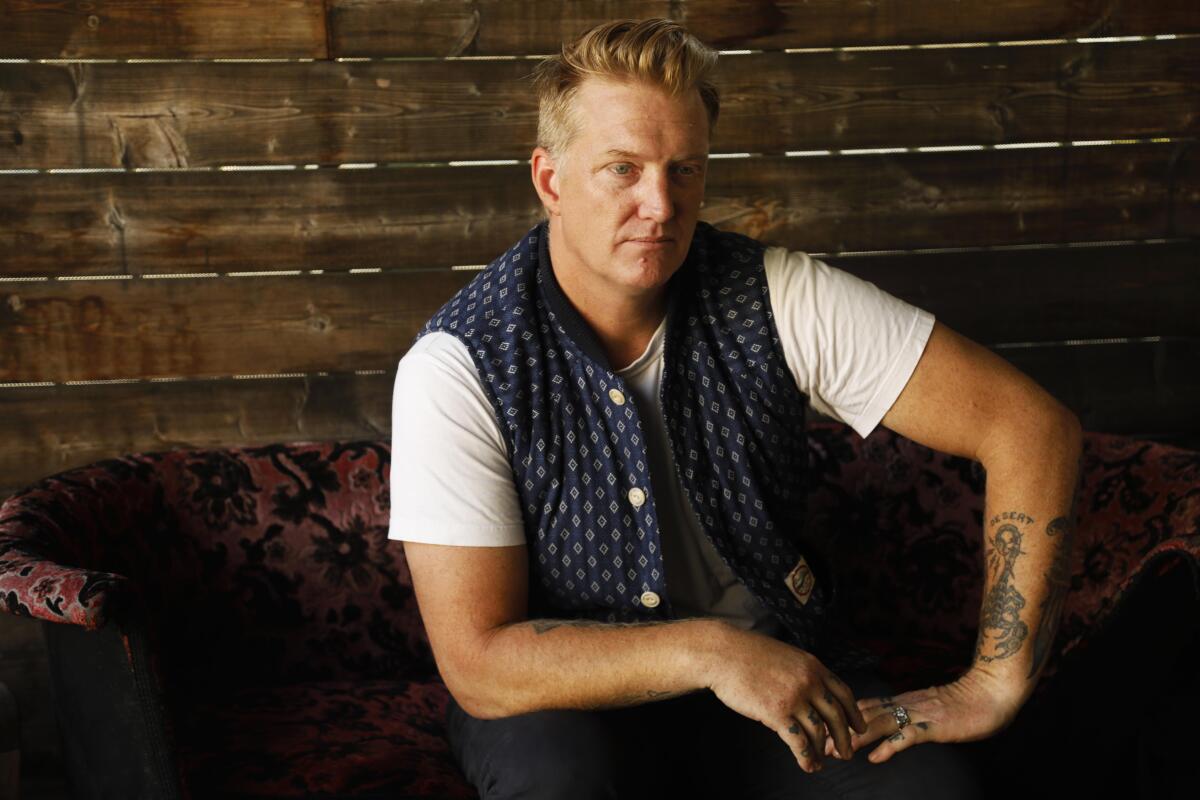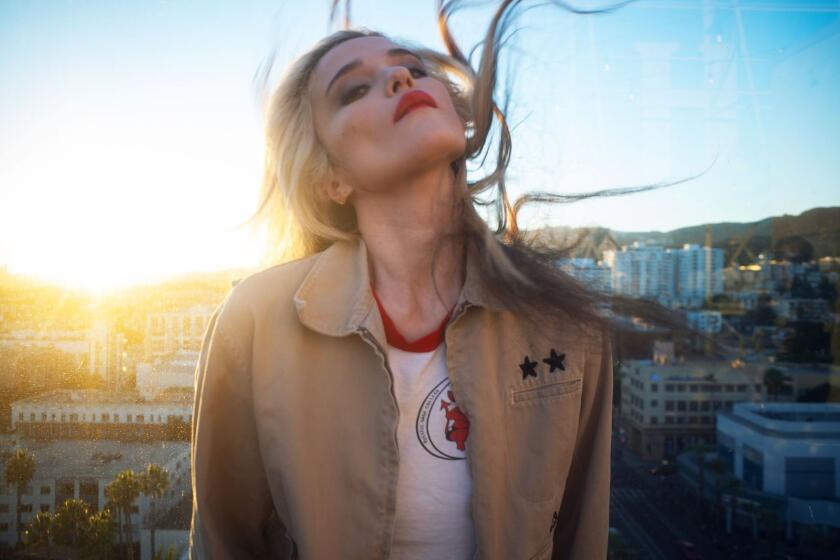After 16 years, Josh Homme rekindles the ‘Desert Sessions’: ‘This will outlast everything I do’

- Share via
In the private recording studio in Burbank he calls Pink Duck, Josh Homme is contemplating his next act of improvisation. The Queens of the Stone Age bandleader is not making music at the moment but plotting a bit of absurd comedy with filmmaker Liam Lynch.
They’re making a short promotional video for the album “Desert Sessions Vol. 11 & 12,” the latest in Homme’s ongoing series of experimental recordings, created at Joshua Tree, with an invited cadre of disparate rock musicians. The plan is for him to appear on-camera in a dark cloak, presiding over a mock Satanic ritual with a pentagram on the floor and a skull-shaped chalice overflowing with dry-ice fog.
Homme wonders, “Should I be saying some type of Latin?”
As it happens, two of his “Desert Sessions” players — drummers Stella Mozgawa of Warpaint and Carla Azar of Autolux — are here. Both are quickly recruited into the skit, given lines and direction. Mozgawa tries on a horned helmet.

This sort of spontaneous creativity is at the core of the “Desert Sessions” project, says Homme, 46, who started presiding over the series in 1997. Most of “Desert Sessions Vol. 11 & 12,” set for release on Oct. 25, was recorded during six days at a small desert studio called Rancho de la Luna, with a cast that included ZZ Top singer-guitarist Billy Gibbons and Primus singer-bassist Les Claypool, among others.
“He said, ‘Come on out to Joshua Tree and bring your six-string and let’s see what kind of mystery we can get in,’” says Gibbons, who first worked with Homme as a guest on the 2006 Queens album “Lullabies to Paralyze.” “To me that’s always a sprightly invitation. I never know exactly what he may have up his sleeve, but it’s usually something intriguing.”

The new “Desert Sessions” album is the first since 2003, resurrecting a dormant tradition that has previously led to collaborations with PJ Harvey, Mark Lanegan, members of Ween and Soundgarden and many others. Rancho de la Luna is on a bluff overlooking Joshua Tree National Park; it’s filled with idiosyncratic recording gear and a raw desert vibe curated by studio owner (and guitarist) Dave Catching.
The songs are recorded in two multiday sessions, by two separate groups of musicians, with one day of overlap. Most of the musicians stay in adjacent cabins around the studio. Homme acts as wisecracking producer and master of ceremonies into the early morning hours, trading ideas, giving encouragement and delivering an open-ended stream of absurd jokes.
“The elephant in the room is we get to be around constant comedy,” Azar says of Homme. “I played drums, I drank and I just laughed the entire time I was there.”
Much of the music reflects an aesthetic for the muscular and eccentric familiar to Homme followers, but with left turns that come from first-time collaborations. Homme calls the recording sessions “a genre-busting machine.”

With Queens of the Stone Age, Homme has been a leading force in alternative rock for over 20 years, playing music of strange elegance and brutal swing, with radio hits (“No One Knows,” “The Way You Used to Do”) and international headlining tours. Gibbons describes Homme’s unconventional, kinetic guitar work and general musical attitude as “a curious meandering. Josh throws caution to the wind. Call it jazz, call it blues, call it adult chords ... he embraces the avant-garde.”
“In terms of notoriety, I really have no interest in getting any bigger,” says Homme, also a committed family man with three young children and a successful punk-rock wife, Brody Dalle of the Distillers. “And if it were a little smaller, I’d probably be fine with that because there’s nothing down that road — unless it allows me to pull musicians from a farther world to do this.”
His career may be entering a new phase, following QOTSA’s uptempo “Villains,” listed among the best albums of 2017 by Rolling Stone. “After the last Queens tour, I needed to take a break. I don’t think that style of putting out 10 more songs and touring for two years, I could ever do again like that,” explains Homme, who has lately been dabbling in writing movie soundtracks. “So I was like, ‘I’m going to sit and watch.’”
He’s never released a solo album, instead preferring the electricity of interacting with one or more peers under a shared banner, and over the years has recorded with an unlikely lineup of players, from Trent Reznor to Elton John. It’s that tradition, and the mutual admiration of these players, that fuels the experiments of “Desert Sessions,” serving their common “romantic idealism, the visions that make you excited and give you goosebumps,” Homme says.
More than two hours from Los Angeles, Rancho de la Luna provides both a good time and a workshop where early glimpses of QOTSA fan-favorites have first appeared, including “Monsters in the Parasol” and “Make It Wit Chu.” An early version of the Eagles of Death Metal, his band with singer-guitarist (and high-school sidekick) Jesse Hughes, made its debut there.
“It’s a small house, and you’re making guac for each other,” says Homme, tall and red-haired in a blue vest. “I’ve done vocals in the bathroom and played drums with a snare on the toilet. I played drums on the roof. You do these bizarre things.”
Homme had talked of doing another “Desert Sessions” set for years, even as outside projects filled his calendar: Eagles of Death Metal, super-group Them Crooked Vultures and being producer-bandleader on Iggy Pop’s acclaimed 2016 album (and tour) “Post Pop Depression.”
A missed opportunity brought new urgency to his mind after the 2015 death of hard-rock icon Lemmy Kilmister, the singer-bassist of Motörhead. Both Kilmister and Gibbons had agreed to be part of the next “Desert Sessions,” scheduled for when Homme finished his work with Pop, but it was too late.
“I really need to push harder when I feel something really strongly,” Homme says of missing his chance to put Kilmister and Gibbons in a studio together. “This is an opportunity to play Cupid [between musicians] and to watch and sonically capture that love affair.”
Homme grew up in Palm Desert, where his first band of shaggy hard-rock misfits, Kyuss, emerged with a searing “stoner-rock” sound, fueled by obsessive listening to the uncompromisingly heavy Black Flag and Black Sabbath. QOTSA took the reputation even further for a certain tight-knit group of desert-based musicians, who began by playing punk-rock generator parties among the sand dunes. That makes the “Desert Sessions” location always a homecoming for Homme, and an irresistible draw for his celebrated guests, while the isolation and barren environment contribute to a sense of mystery and camaraderie.
“Some of the most interesting music has been made in isolation,” says Mozgawa. “And this is that writ large, because you’re not distracted by being in L.A. You’re stripped of all your luxuries, even though it’s a beautiful place, and the wines were flowing.”
Homme adds: “All your errands are impossible.”
After Azar was invited to be part of the project, she spoke with her friend PJ Harvey, who was central to the last sessions, “Volumes 9 & 10,” in 2003. “She still talks about it as one of her favorite times,” says Azar, also a drummer for Jack White.

While most “Desert Sessions” albums have been low-profile indie releases known mainly to the most hardcore QOTSA fans, the last project got new attention at least partly from the charged combination of Harvey and Homme. It produced the first single (and music video) ever released by the project, “Crawl Home.”
But the intimate desert venue of Rancho de La Luna was an unfamiliar way of working, as Harvey told Homme on the ride out to the desert. “She was like, ‘I don’t like to sing in front of people and try things,’” recalls Homme. “Six hours later, she was on her knees on the carpet with magazines and lyrics and all this stuff, singing while other people are just on the couch being like, ‘Who wants tea?’”
On the new album, the experiments also serve as a setting for personal statements, as on the shadowy folk ballad “If You Run,” with vocals by newcomer Libby Grace, which tells a “bad-luck story,” says Homme. And on the shimmering, spectral “Something You Can’t See,” featuring vocals from the Scissor Sisters’ Jake Shears, “Jake is singing about the confusion and loneliness he’s experienced about being gay,” says Homme. “I was so stoked to be part of a song where that’s what it’s about, especially in such an FM-hit-sounding song. How often is that even a possibility?”
While the last “Desert Sessions” release also led to the first-ever public performances of the group in 2004 — at both Coachella and on U.K. television show “Later ... With Jools Holland” — Homme doesn’t foresee that this time around. For him, the give-and-take with a group of comrades and collaborators is more about the moment of creation and showing a possible future path.
“If I can reframe Billy Gibbons in a way that he’s comfortable with, can I reframe myself someday?” he says. “This is something that could outlast everything else I do because it’s not really me — it’s me being myself with other people being themselves. It’s not responsible to one person. I’m inviting people, but what it sounds like is not anyone’s fault. It’s everyone’s fault.”
More to Read
The biggest entertainment stories
Get our big stories about Hollywood, film, television, music, arts, culture and more right in your inbox as soon as they publish.
You may occasionally receive promotional content from the Los Angeles Times.









